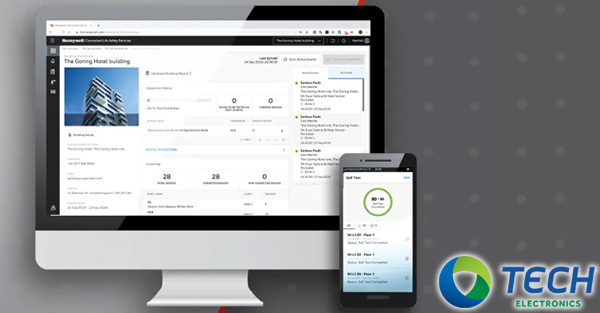By: Sean Devereaux, Director of Customer Base Sales
In recent years, one of the most significant and most observable trends in the technology space has been a push for greater connectivity. By this point, most people are familiar with the huge advantages that smart technologies offer, but one piece of technology has lagged: the Fire Alarm.
Over much of recent history, most advances in fire alarm technology have been relatively slow, small, and code-driven. However, that’s all changing, as smart technology is gaining an increasing foothold in the fire prevention space. For everyone involved, from building owners and facilities managers to Authorities having jurisdiction, this is a huge, revolutionary step forward.
But how, exactly? How much could you really want from your fire alarm? Well, to help explain that and more, I’ve enlisted Susan Gehring, our Director of Fire Systems, for a conversation about it.
Sean: Fire alarm is often discussed as a technology without an end-user, as it’s not something you’d generally choose to interact with unless you need to. But what happens when you do?
Susan: I can see the thinking – the perfect fire alarm is the one you never even notice because nothing’s ever wrong, right? But let me make an analogy: imagine you broke your arm, went to get an X-Ray, and instead of getting the results in terminology you can understand, the radiologist just gave you a bunch of incomprehensible technical jargon that doesn’t make any sense to you and sends you on your way.
What do you do now? Do you need surgery, or a cast, or an additional trip to the orthopedist? That’s kind of how it’s always worked with your fire alarm: you get no care plan. Yet, this is important information that affects the health of your building. Don’t you want to receive it in a way that makes sense to you and is actionable, rather than just relying on somebody else to interpret it for you?
Sean: Right, so if something went wrong in the middle of the night, you’d get a call from the central monitoring station, and supposing you actually answer it, what they can tell you is that your panel is giving an alert that says “Trouble, Alarm, or Supervisory.” Chances are, that doesn’t mean much in isolation, right?

Susan: And maybe you’re burning three hours of overtime and sending a maintenance worker up to the building in the middle of the night, only to find that it was just a low battery warning. Now, there’s a piece of technology called a Connected Gateway that serves as a virtual bridge, connecting your control panel to a cloud platform, and even integrating with mobile devices. So instead of having to have a person at the physical location of your panel, you get a push notification about that low battery. Armed with that information, you get to determine that it isn’t urgent, and you can address it in the morning.
On the flip side, if you get a supervisory alert on your sprinklers in the dead of winter, that might be a “low air” alert, which likely means the pipe is filling with water and will burst soon. Obviously, that’s not one you’d want to sleep on. So having more actionable information puts you in a position of strength.
Sean: For somebody already upgrading from expensive POTS (Plain Old Telephone Service) lines for their monitoring or upgrading from 3G/4G wireless coverage because that technology is sunsetting. They might see the value in a Connected Gateway that helps make their monitoring more effective and useful. But how can more connectivity down the chain help their business?
Susan: Well, Notifier’s INSPIRE panel is certainly designed to integrate with the Connected Gateway, to give you as much visibility into your system as possible, and having a simple touchscreen, graphical user interface makes a fire alarm control panel much more accessible than has usually been the case.
But beyond that, one of the most exciting developments is the Self-Test series of detectors.
Sean: Right, because everyone hates compliance inspections…
Susan: Everyone does. It’s a time-consuming process that ties up manpower and disrupts normal operations in your building. But with Self-Test detectors, you no longer have to do traditional smoke tests and can just run a functional self-test and a quick visual inspection. That means you don’t necessarily need direct access to those spaces and can run tests while they’re otherwise occupied.
All in all, that means fewer technicians on-site, fewer of your maintenance people tied up, and the entire process can often be cut down from taking a few days to several hours as a result.
Sean: And then, once you’ve had your inspections done, you never have to worry about finding your inspection reports should you need them, since with these connected technologies they’ll be stored securely in the cloud with an audit trail.
Susan: Exactly, so we’re sliding back up the chain. There’s a layer of connectivity at each link in that chain that provides a meaningful value add, whether it’s making your fire solutions easier to use, quicker and more efficient, and more cost-effective. In many cases, it’s all three.
Sean: And this is an adaptable, scalable solution as well. You might start with the gateway because you were already looking to upgrade your monitoring communicator. But as your needs evolve, or your old technology becomes unsupported, or your business grows, there’s always an opportunity to incorporate improved technology that makes your life easier. Thanks, Susan, for sharing your expertise with us.
So there you have it: technological growth may have stalled in the fire alarm space for quite a while, but now it’s making up for lost time and improving by leaps and bounds. Smart technology means more connectivity, more information, and more control over the way you run your building and help keep it safe. And better still, this is just the beginning. As more and more stakeholders see the value of these connected solutions, who knows what improvements are yet to come?


